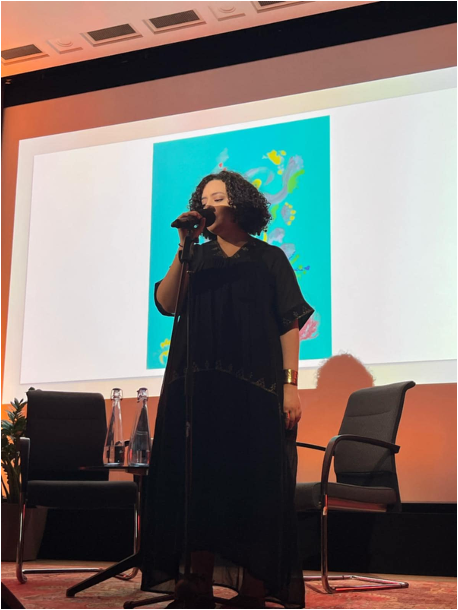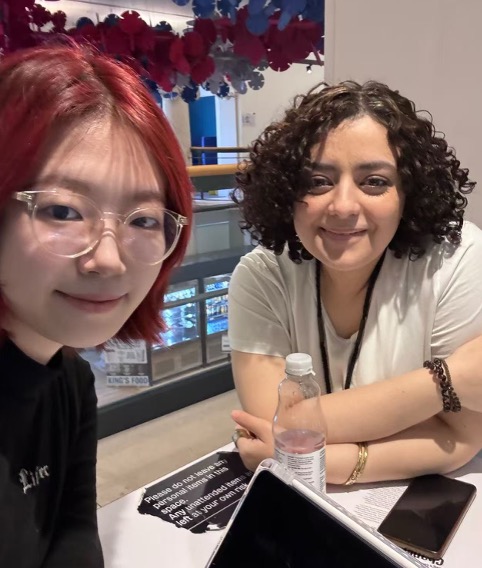Archive, Generation, and the Shaping of Identity — A Conversation with Beyond 1932 Residency Artist Sara Hamdy

On the evening of March 31st, Sara Hamdy, a visual and sound artist from Egypt (b. 1987), delivered an outstanding lecture performance at the Pigott Theatre in the British Library. She presented a thorough and in-depth exploration of the life and musical legacy of Egyptian-American composer and ethnomusicologist Halim El-Dabh (1921–2017), and incorporated samples of his work into her own performance.
In a subsequent interview with Sara, I noticed that she consistently referred to the concept of the “archive” when discussing her artistic practice. Why is the archive so important? Sara recounted her experience during an artist residency in 2019 at Radio Corax in Germany, where she was asked to introduce the state of sound art in Egypt.
“I had almost nothing to say,” she told me. “I was actually aware of many tangible examples of sound art in Egypt, but when I tried to search for these artists online, I found that aside from a few names, mostly supported by international institutions, there was practically nothing to be found.”
This was one of the reasons that prompted her to launch “Sonic Spaces” in 2021, a website dedicated to collecting and documenting contemporary Egyptian sound art and sonic research, and to transferring this knowledge through an online pedagogical platform and an on-site space. This work also led her to participate in the Beyond 1932 Residency, through which she delved into the sonic heritage of Egypt’s past.
In our conversation, I came to see Sara as an artist of remarkable sensitivity. Her background in visual arts during her university years endowed her with a keen eye for visual perception. Her early project experiences cultivated a practice rooted in research. Meanwhile, her interest in field recording and graphic scores sharpened her sensitivity to the sonic world. As a result, Sara has developed a multifaceted approach to media. To her, all perceivable surroundings of human existence can be brought into the work of archiving. The archive can transcend media and space-time, holding the dual power of retrospection into the past and generation toward the future.
Even though Halim is already the most well-known among Egyptian sound artists, the materials available about him are still noticeably fewer than those concerning his Western contemporaries. In fact, as a master’s student who has studied musicology for four years, this was the first time I had ever heard Halim’s name. Most of the archival resources I’ve encountered related to 20th-century American sound art have always focused on figures like Cowell, Cage, and Varèse. So, when I learned, on the evening of March 31st, that Halim was the first person in history to compose tape music (or musique concrète), and that he moved within the same circles as these widely recognized composers, I was genuinely shocked.
Later, when I searched online for existing scholarship on Halim, I found that both the quantity and depth of the research were extremely limited, and that most of the researchers were based in the Western world. Sara told me that she had once visited several formal archives—such as the American University in Cairo and the Bibliotheca Alexandrina—and found that their collections contained very little information about Halim. She then contacted Halim’s wife, Deborah, and his son, Habib.
Through conversations with them, she was able to gather more personal and valuable materials, which she went on to archive and interpret. Sara also reached out to artists and researchers who had either collaborated with Halim or collected his works, including Joe Namy, Hassan Hujairi, Nicolas Puig, Blake Tyson, and the young archivist Amr Noshy. Their contributions played a major role in her research process.

One particularly moving moment during the event at the British Library was the unexpected arrival of Halim’s nephew and great-niece. They were deeply touched by the project and brought with them photographs of Halim in his youth, which added a powerful emotional layer to the evening.
When I asked Sara about her future plans, she told me that she intends to continue her research on Halim. Her next step may be to visit Northwestern University in the United States to work with and further explore archival materials, and potentially digitize them. Afterwards, she hopes to return to Cairo to organize an event in Halim’s honor—and ideally, to invite more of Halim’s surviving relatives and friends.

Sara is not only compiling these archives; she also sees herself, as an artist, offering a personal interpretation of Halim. The most unforgettable part of the event for me was her performance. She sampled a six-note motif from Halim’s piece The Dog Done Gone Deaf, with the help of electronic musician Mohamed Ragab, who looped it while Sara layered an improvised chant over the top. Through the slow, rising and falling waves of sound and her ethereal voice, the audience could sense a kind of temporal unfolding, as if history were opening up before our eyes and Halim’s musical legacy was engaging in an energetic exchange with the sounds of the present.
In the interview, Sara mentioned that this reflects a minimalist aesthetic she is drawn to—one that focuses our attention on the vibration of sound, and through that, invites reflection on the vibration of life itself. This, she said, is also central to Halim’s musical philosophy. I believe Sara’s creative work has infused the archive with a generative force—one that allows us to hear not only Halim’s voice, but also a more expansive and vital future voice, interwoven with Sara’s own reflections.

At the end of our interview, I asked Sara how she views the marginalization of Halim’s work and archive within a Western-centric global order. To my surprise, she offered a remarkably optimistic response. She believes that such marginalization is understandable, given that the power to shape history has always belonged to those who write it. However, as an Egyptian sound artist and researcher, she sees it as far more important to engage in concrete work—to research her own country’s musical heritage and amplify the voices that have been overlooked.
“We have a responsibility to think about and challenge these dominant narratives,” she said. While responsibility may come with pressure, Sara believes that we have to do it. For her, this is an inevitable task when trying to balance study with creation. And in this very process, she added, we are also able to more clearly express who we are—shaped as we are by our social, cultural, and racial identities.
This brought to mind the theme of the project: Beyond 1932. Traditionally, we imagine the 1932 Cairo Congress as a moment when Western “authority” sought to “guide” the musical cultures of the East. But from a more constructive perspective, perhaps it also marked a meaningful beginning—a moment where different civilizations could begin to redefine their identities through the juxtaposition of archives. Neither Halim’s nor Sara’s music carries clear ethnic markers in their sound. Yet, the very process of creation for both of them begins with the question of self-definition—whether as sound artists, Egyptians, or responsible archival workers. These identities ultimately converge into a collective force that drives their artistic action.

Nora Zhang, Master’s student in Music at King’s College London. Her research focuses on sound studies and noise music.

